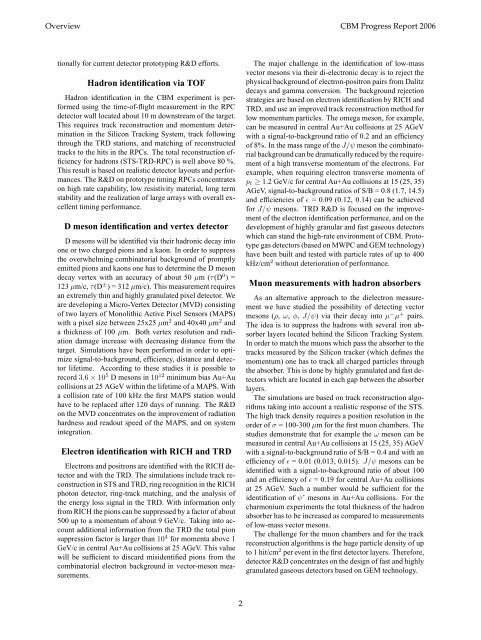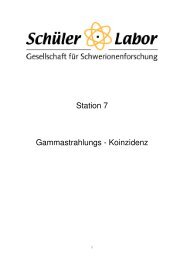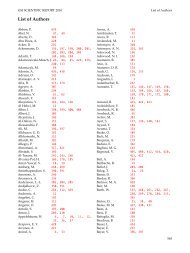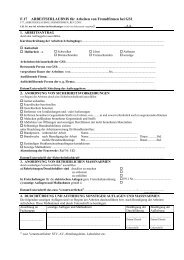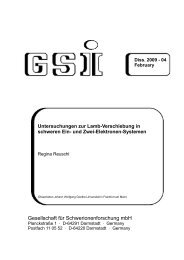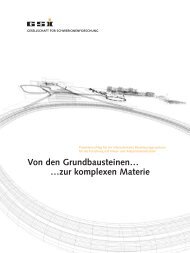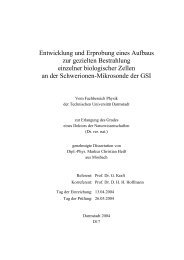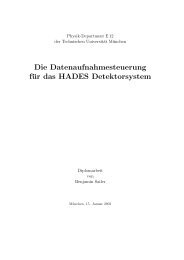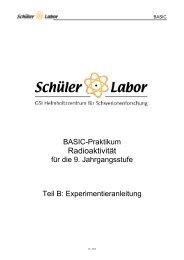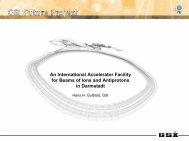CBM Progress Report 2006 - GSI
CBM Progress Report 2006 - GSI
CBM Progress Report 2006 - GSI
You also want an ePaper? Increase the reach of your titles
YUMPU automatically turns print PDFs into web optimized ePapers that Google loves.
Overview <strong>CBM</strong> <strong>Progress</strong> <strong>Report</strong> <strong>2006</strong><br />
tionally for current detector prototyping R&D efforts.<br />
Hadron identification via TOF<br />
Hadron identification in the <strong>CBM</strong> experiment is performed<br />
using the time-of-flight measurement in the RPC<br />
detector wall located about 10 m downstream of the target.<br />
This requires track reconstruction and momentum determination<br />
in the Silicon Tracking System, track following<br />
through the TRD stations, and matching of reconstructed<br />
tracks to the hits in the RPCs. The total reconstruction efficiency<br />
for hadrons (STS-TRD-RPC) is well above 80 %.<br />
This result is based on realistic detector layouts and performances.<br />
The R&D on prototype timing RPCs concentrates<br />
on high rate capability, low resistivity material, long term<br />
stability and the realization of large arrays with overall excellent<br />
timing performance.<br />
D meson identification and vertex detector<br />
D mesons will be identified via their hadronic decay into<br />
one or two charged pions and a kaon. In order to suppress<br />
the overwhelming combinatorial background of promptly<br />
emitted pions and kaons one has to determine the D meson<br />
decay vertex with an accuracy of about 50 µm (τ(D 0 ) =<br />
123 µm/c, τ(D ± ) = 312 µm/c). This measurement requires<br />
an extremely thin and highly granulated pixel detector. We<br />
are developing a Micro-Vertex Detector (MVD) consisting<br />
of two layers of Monolithic Active Pixel Sensors (MAPS)<br />
with a pixel size between 25x25 µm 2 and 40x40 µm 2 and<br />
a thickness of 100 µm. Both vertex resolution and radiation<br />
damage increase with decreasing distance from the<br />
target. Simulations have been performed in order to optimize<br />
signal-to-background, efficiency, distance and detector<br />
lifetime. According to these studies it is possible to<br />
record 3.6 × 10 5 D mesons in 10 12 minimum bias Au+Au<br />
collisions at 25 AGeV within the lifetime of a MAPS. With<br />
a collision rate of 100 kHz the first MAPS station would<br />
have to be replaced after 120 days of running. The R&D<br />
on the MVD concentrates on the improvement of radiation<br />
hardness and readout speed of the MAPS, and on system<br />
integration.<br />
Electron identification with RICH and TRD<br />
Electrons and positrons are identified with the RICH detector<br />
and with the TRD. The simulations include track reconstruction<br />
in STS and TRD, ring recognition in the RICH<br />
photon detector, ring-track matching, and the analysis of<br />
the energy loss signal in the TRD. With information only<br />
from RICH the pions can be suppressed by a factor of about<br />
500 up to a momentum of about 9 GeV/c. Taking into account<br />
additional information from the TRD the total pion<br />
suppression factor is larger than 10 4 for momenta above 1<br />
GeV/c in central Au+Au collisions at 25 AGeV. This value<br />
will be sufficient to discard misidentified pions from the<br />
combinatorial electron background in vector-meson measurements.<br />
2<br />
The major challenge in the identification of low-mass<br />
vector mesons via their di-electronic decay is to reject the<br />
physical background of electron-positron pairs from Dalitz<br />
decays and gamma conversion. The background rejection<br />
strategies are based on electron identification by RICH and<br />
TRD, and use an improved track reconstruction method for<br />
low momentum particles. The omega meson, for example,<br />
can be measured in central Au+Au collisions at 25 AGeV<br />
with a signal-to-background ratio of 0.2 and an efficiency<br />
of 8%. In the mass range of the J/ψ meson the combinatorial<br />
background can be dramatically reduced by the requirement<br />
of a high transverse momentum of the electrons. For<br />
example, when requiring electron transverse momenta of<br />
pt ≥ 1.2 GeV/c for central Au+Au collisions at 15 (25, 35)<br />
AGeV, signal-to-background ratios of S/B = 0.8 (1.7, 14.5)<br />
and efficiencies of ɛ = 0.09 (0.12, 0.14) can be achieved<br />
for J/ψ mesons. TRD R&D is focused on the improvement<br />
of the electron identification performance, and on the<br />
development of highly granular and fast gaseous detectors<br />
which can stand the high-rate environment of <strong>CBM</strong>. Prototype<br />
gas detectors (based on MWPC and GEM technology)<br />
have been built and tested with particle rates of up to 400<br />
kHz/cm 2 without deterioration of performance.<br />
Muon measurements with hadron absorbers<br />
As an alternative approach to the dielectron measurement<br />
we have studied the possibility of detecting vector<br />
mesons (ρ, ω, φ, J/ψ) via their decay into µ − µ + pairs.<br />
The idea is to suppress the hadrons with several iron absorber<br />
layers located behind the Silicon Tracking System.<br />
In order to match the muons which pass the absorber to the<br />
tracks measured by the Silicon tracker (which defines the<br />
momentum) one has to track all charged particles through<br />
the absorber. This is done by highly granulated and fast detectors<br />
which are located in each gap between the absorber<br />
layers.<br />
The simulations are based on track reconstruction algorithms<br />
taking into account a realistic response of the STS.<br />
The high track density requires a position resolution in the<br />
order of σ = 100-300 µm for the first muon chambers. The<br />
studies demonstrate that for example the ω meson can be<br />
measured in central Au+Au collisions at 15 (25, 35) AGeV<br />
with a signal-to-background ratio of S/B = 0.4 and with an<br />
efficiency of ɛ = 0.01 (0.013, 0.015). J/ψ mesons can be<br />
identified with a signal-to-background ratio of about 100<br />
and an efficiency of ɛ = 0.19 for central Au+Au collisions<br />
at 25 AGeV. Such a number would be sufficient for the<br />
identification of ψ’ mesons in Au+Au collisions. For the<br />
charmonium experiments the total thickness of the hadron<br />
absorber has to be increased as compared to measurements<br />
of low-mass vector mesons.<br />
The challenge for the muon chambers and for the track<br />
reconstruction algorithms is the huge particle density of up<br />
to 1 hit/cm 2 per event in the first detector layers. Therefore,<br />
detector R&D concentrates on the design of fast and highly<br />
granulated gaseous detectors based on GEM technology.


